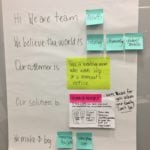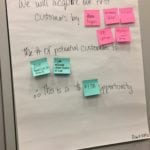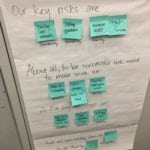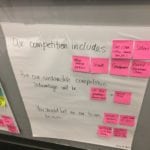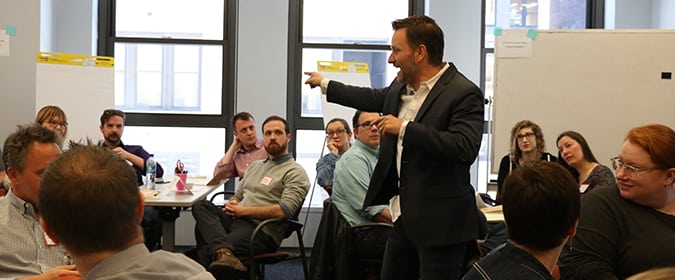
The News Media Alliance is partnering with Google News Initiative and Matter to take local news publications through a series of innovation bootcamps to help them find new ways to increase their audience and revenue shares. I attended the first boot camp, called Open Matter, in New York, to see what they’re all about. Here’s what other newsrooms can expect when they attend future bootcamps.
What to Expect from Open Matter
Open Matter is all about changing how you think and how you approach the challenges facing your newsroom. The bootcamp is based in “design thinking,” a way of working through a problem that involves such things as “empathy research” and writing a point-of-view before even contemplating a possible solution.
A few important things to know: 1) You will not be working with your core team, so consider bringing people from across your newsroom so you’ll better be able to share the wealth of knowledge when you return home at the end of the bootcamp, and 2) while the course is about innovation in local newsrooms, you will not, during the three days, be required to come up with a product for your newsroom, so come in with an open mind and be willing to go where the process takes you.
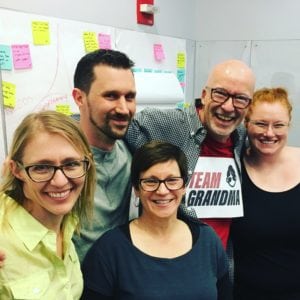
Right now, you’re probably wondering, “What is this ‘design thinking’ anyway?” Design thinking is a way of attacking a problem that focuses first and foremost on your audience. In the news business, the product — the news — is all about the audience. But in design thinking, it’s not about doing what you think the user needs or what’s best for them. Instead, design thinking is grounded in getting to know your users and understanding their lives. What do they want out of life? What do they feel they need to get there? What are their hopes and dreams for their future? In design thinking, knowing your audience intimately and understanding who they are at their core is essential to creating a product that is both useful and meaningful for their everyday lives. That’s why the first component of design thinking is desirability, and the first step in the process is conducting empathy interviews.
Finding Desirability
It started with a question Matter assigned each group. We took to the streets of New York to search for answers from readers. It was admittedly more difficult to conduct these empathy interviews without knowing what we were expecting to produce. As such, it took a little more effort to figure out what we were asking and what we hoped to find out from those questions.
As a journalist, I often interview people about their needs, but having such an open-ended conversation was slightly uncomfortable — I didn’t know how to explain why I was asking people to give me their time and talk to me. My colleagues had an easier time with the open-ended nature of the questions, but admitted that they had a harder time digging deeper with their subjects, so we balanced each other out nicely.
Once we’d gathered as many interviews as possible, the Matter team then walked us through creating POVs (point-of-view statements) about our interview subjects: statements from the people we’d interviewed using a basic format (below) to get an idea of who our audience might be and what they needed.
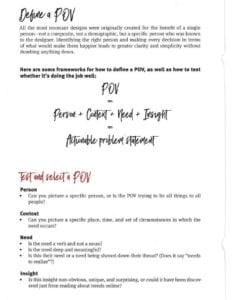
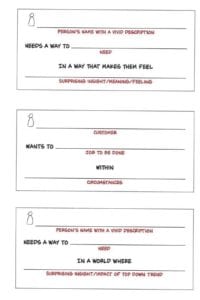
On day two of the bootcamp, we worked more with our POVs, landing on (what we thought would be) our final version — a POV for Tina — before delving into the actual product design. On Tuesday morning, our question was no longer “Who are we helping?” but “How are we helping them?”
Classmates drafted products like specialized websites, knowledge databases, apps and physical products and services, each designed to serve their own POVs.
My teammates and I had the hardest time with this part of the process. For one thing, the more we focused on what we were hoping to create, the more we felt the need to rewrite our POV and rethink what it was our user (Tina) needed. But we also had a hard time agreeing on what it was we wanted to create for Tina. Most of us went headfirst into apps, but one teammate hated the idea of creating an app and wanted us to try something more original. Because of this, it took us a while to hammer out an agreement on what we were building and how it would work.
Luckily, Matter builds into their bootcamp some important lessons about feedback and communication. And as hard as it is to give feedback to people you’re working with, the nature of our relationships (we were only going to be paired together for three days and then we could, in theory, never see each other again) made it easier in many ways to have those difficult conversations. I argued (politely) with one particular teammate several times throughout the three days, but it wasn’t combative — we’d both just become incredibly attached to our ideas, and had to learn to let go a bit and let our proposals evolve with input from each other and the rest of our group.
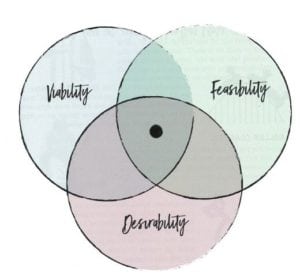
How Do We Bring It to Life?
It may seem strange not to consider the feasibility and viability of these ideas until more than halfway through the workshop, but until you have a POV and a known product, you can’t consider what it will take to get that product off the ground and keep it afloat. While both are essential to the process, they are the things that often keep people from thinking up new ideas and creating new products, especially in newsrooms.
During this process, we presented our pitches to our fellow participants, each group partnering with another group to exchange feedback. It gave us a chance to see not only how our POVs were received, but to get an outside opinion on our feasibility and design.
From feasibility, we moved onto viability, which is how we would make money from our product.
According to Matter, there are only eight real revenue models.
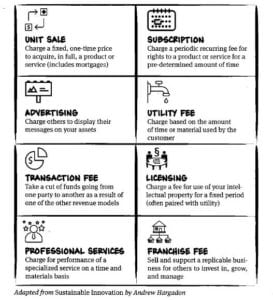
We discussed how the different models would work by testing them out on a hypothetical sandwich business. How would our sandwich business make money if we wanted to use a licensing model or a subscription fee? How would we make money from sandwiches relying only on advertising or franchising?
The process of discussing our hypothetical sandwich business (with its burned-in advertisements on the bread and its special sandwich-a-day subscription, among other revenue models we conceived) helped us learn the various revenue models and how they might intersect and overlap if we combined them.
Once we’d mastered the revenue models, it was time to apply them to our own products and do another practice pitch before retiring for the day.
It is pertinent to pitch new products (at least within your newsroom) when a product is rough so that you can rework it as needed and go through the design process again. Perfection is the enemy when it comes to product development and launch, so we were tossed headfirst into the fire with our rough drafts of our products.
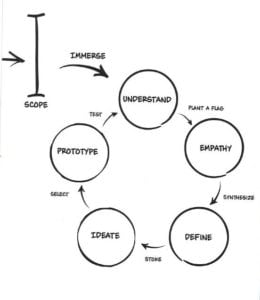
Taking It Home
Each newsroom was asked in their application to provide some projects they were working on that they thought Matter could help them with, and when they returned to their original groups, they were tasked with applying the designing thinking concepts they’d learned at the bootcamp to those projects, and to discuss what their next steps would be using the process we’d all learned. Watching everyone apply their new lessons was fascinating, and the Matter team and I got to see just how much each crew took from the previous three days of class.
What Did I Learn?
After three days, everyone had a lot of news lessons under their belts and had mastered some new ways of thinking. The key takeaway for me, though, was that we need to put our audience first. Stepping outside of the typical way of thinking that I’ve acquired after more than a decade in journalism wasn’t easy, but it reminded me that while we often have our reader/user in mind, we don’t always think to ask them what would really benefit them.
If you are joining Matter in an upcoming bootcamp, it’s important to go in with an open mind and be willing to work through the process. It’s very easy to go in with a problem and assume you know the best solution, but Open Matter forces you to reconsider everything you think is best and turns your thought process on its head. If you’re ready for that and want to bring some really great innovation to your newsroom, then Open Matter’s local news bootcamp is the perfect next step.

